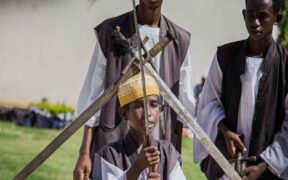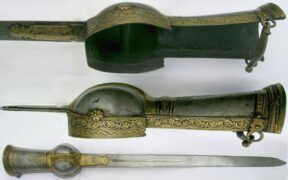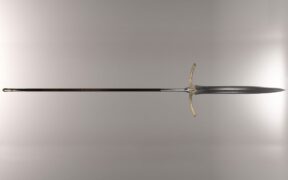Our content features commercial links to our products, committed to transparent, unbiased, and informed editorial recommendations. Learn More
Kasthane Explained: The National Sword of Sri Lanka
NO AI USED This Article has been written and edited by our team with no help of the AI
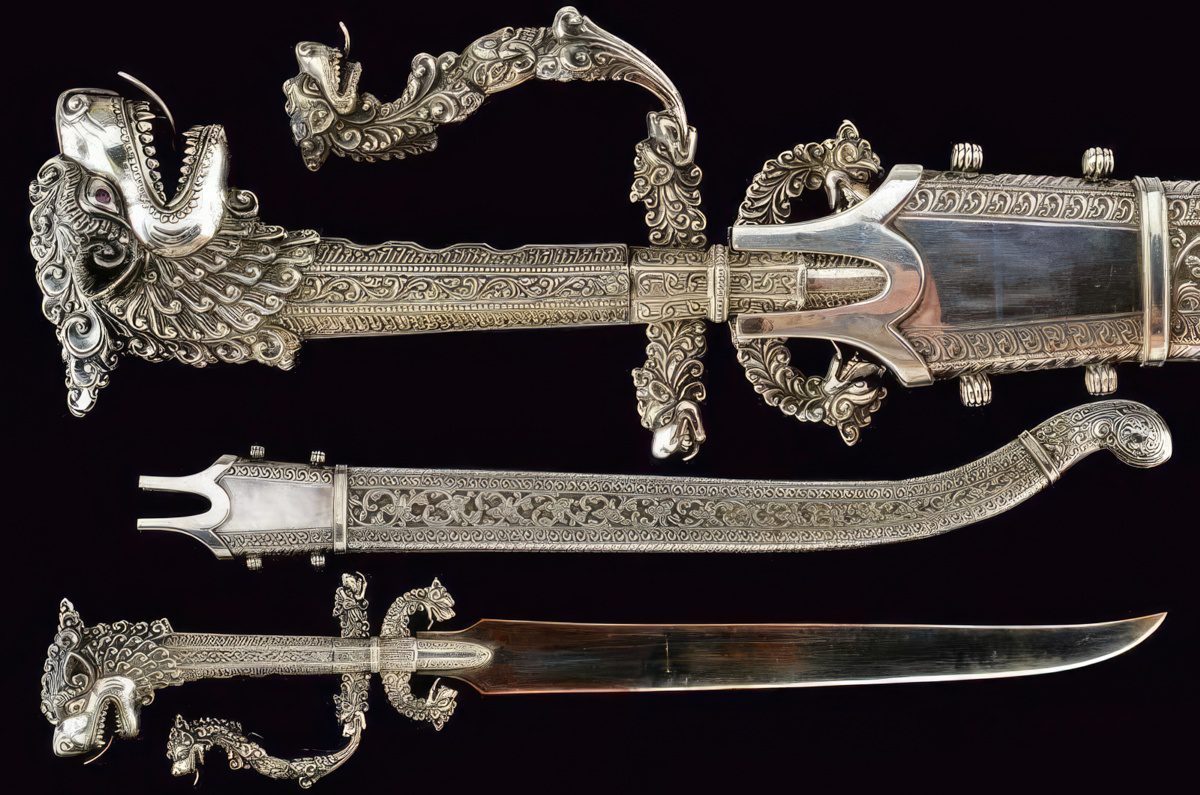
The kasthane, sometimes spelled kastane, is the national sword of Sri Lanka. It is mainly associated with the Kingdom of Kandy, where it served as a badge of rank, fighting weapon, and ceremonial object. Most recognized for its stylized lion head pommel, the kasthane reflects the fine craftsmanship of the Kandyan period.
Let’s explore the craftsmanship and design of the kasthane, its historical uses, and the Sinhala terminologies the sword collectors use.
Characteristics of the Kasthane Sword
The kasthane is notable for its elaborate decoration, mainly its pommel in the form of a mythical beast. However, its quality and craftsmanship vary depending on its intended use.
Here are the unique characteristics of the kasthane:
Metal and Construction
Most of the blades used in kasthane were imported from Europe, though hilts were locally made in the royal workshops of the Kandyan period. Many also featured the mark of the Dutch East India Company. Many had functional blades suitable for fighting while others were purely ceremonial.
Blade Appearance
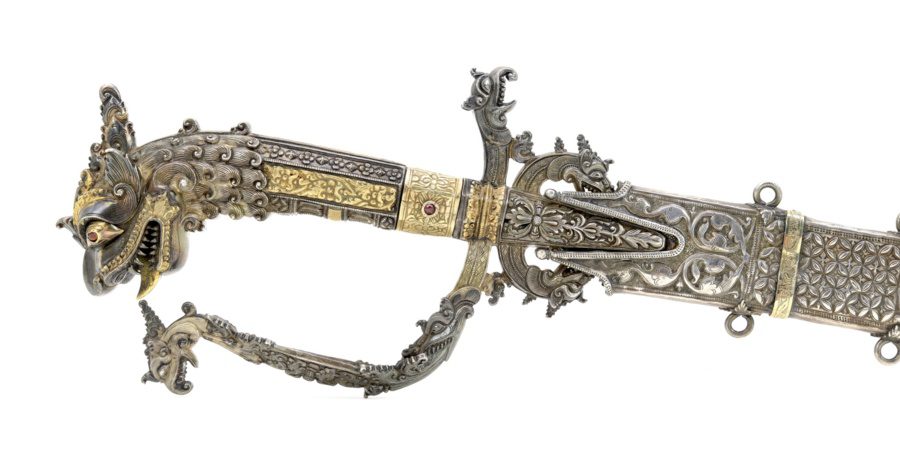
Most kasthane have narrow, single-edged blades, sometimes with grooves or fuller running along the spine on each side. Some fine examples have blades plated with bright yellow alloy which gives the appearance of gold.

Sometimes, the blade’s forte is covered with a silver plate or inlaid with flower designs, usually forms of Sinhalese heraldry. It is also common for presentation swords to be inscribed with a dedication from the donor. In Sinhala, the sword blade is called kadu patha or isa.
Size and Length
The kasthane varied in terms of its length and weight. The average overall length of the sword is around 65 centimeters (25 inches) while the blade ranges from about 38 to 49 centimeters (15 to 19 inches) long. Generally, pure fighting versions were quite heavy while ceremonial ones were lighter.
Sword Mounting
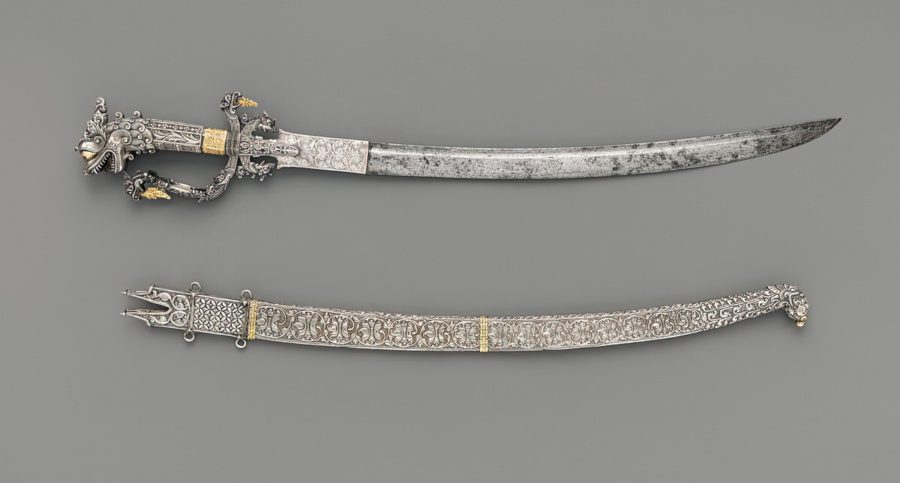
The kasthane has elaborate decorations from the hilt to the scabbard. The quality of decoration varies, but the hilt always features the lion head pommel.
Hilt
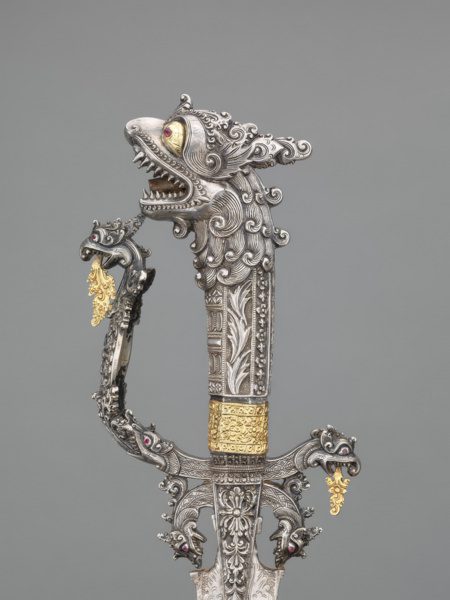
The kasthane swords made in the royal workshops had highly ornamental hilts entirely made of gold, silver, or horn. Gold was reserved for the king while silver was used for the highest officials. Ceremonial versions can also be ornamental, but fighting versions tended to have basic hilt decoration. The term for the hilt in Sinhala is mitta.
Pommel
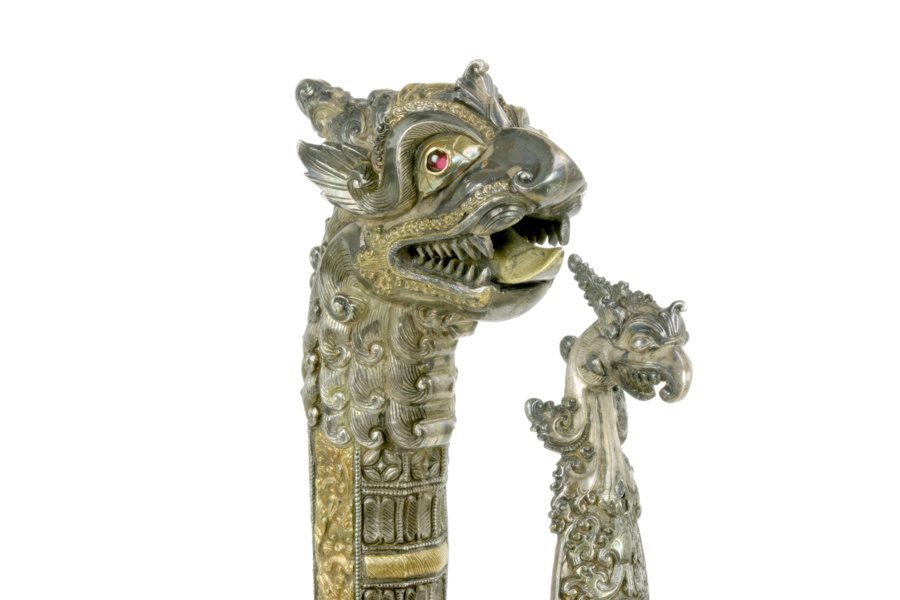
The most striking feature of the kasthane is the pommel, featuring the stylized Sinhalese lion or simha. The simha was the royal emblem of the kings during the Kandyan period and is the national symbol of the Sinhalese people.
In fact, the simha almost exclusively appears on the pommel (gediya) of the kasthane, on the swords of both kings and soldiers. It is sometimes set with gemstones, such as rubies on the eyes. In Sinhala, the term gediya means pommel.
Grip
The grip is often engraved with traditional Sinhalese motifs, ranging from flowers to vines and scrolling designs. Sometimes, the ferrule is made of gold and set with gemstones.
Quillons
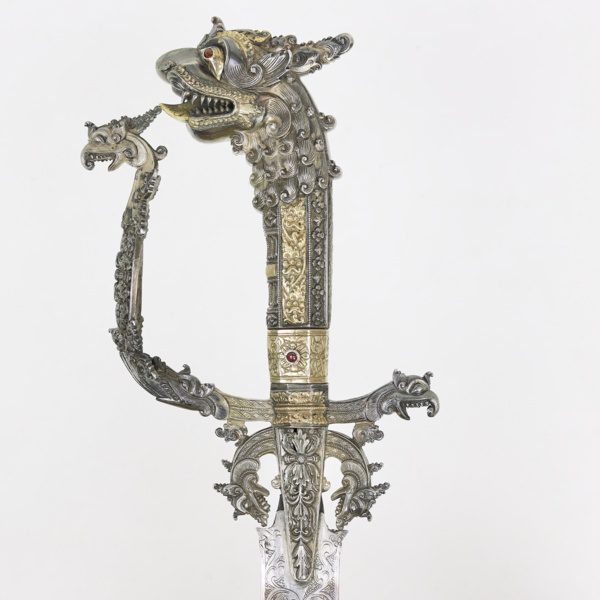
The elaborate guard consists of a crossbar, forming a knuckle bow on one side and a quillon on the opposite side. The quillons (arms of the crossguard) feature the heads of mythical creatures: the sea creature makara and the mythical bird serapendiya.
Usually, two makara heads are curved toward the blade and the opposite of the knuckle guard ends in the serapendiya head. In Sinhala, the term vari sārkawa refers to the quillons of the sword.
Knuckle Guard
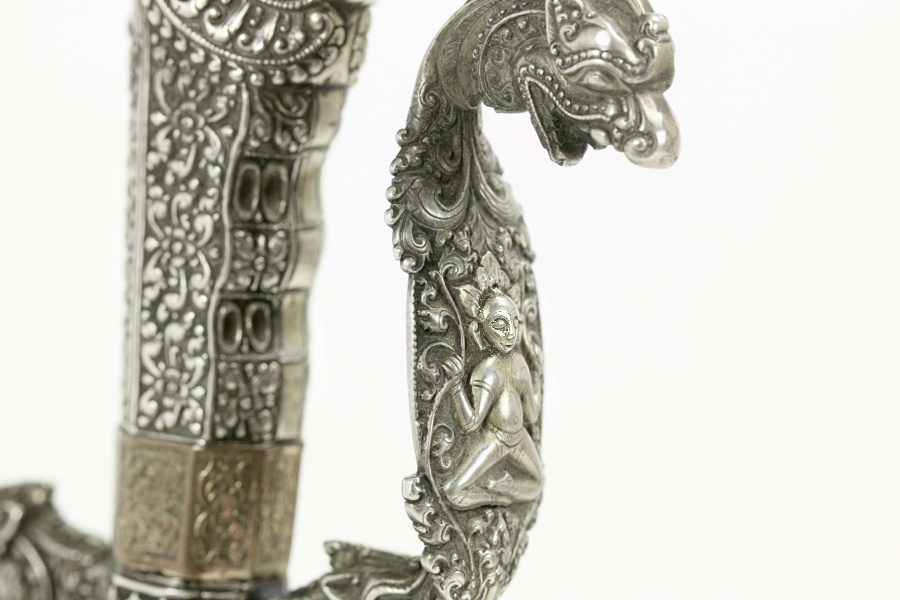
The kasthane has an elaborately carved knuckle guard, sometimes with the figure Lakshmi, the goddess of fortune and abundance. In Sinhala, the knuckle guard is called ath väsma, meaning covering.
Langets
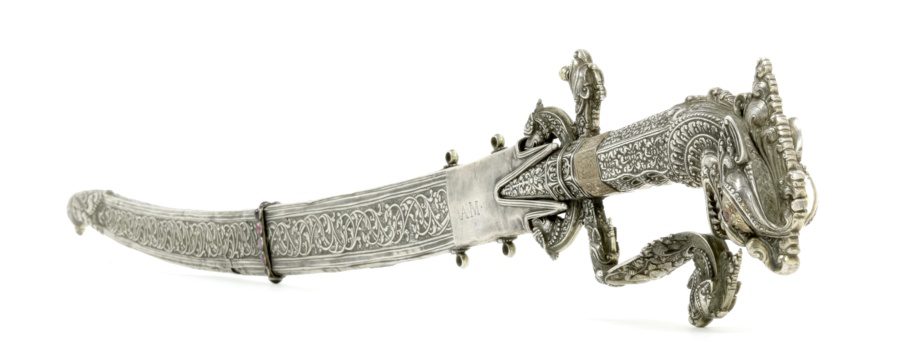
The kasthane has triangular langets extending to the blade, ensuring a tight fit of the sword in the scabbard. They are often chiseled with Sinhalese floral motifs. In literature, the langets are called side plates (alluva).
Scabbard

The scabbards are made of wood or horn, covered with brass, silver, or gold. Most examples had repoussé metalwork featuring geometric, floral, and scrollwork designs. Some also feature bands decorated with gemstones, reinforcing the scabbard and preventing splitting. The scabbard also has small rings or loops for suspension from a belt. The chape, the scabbard’s end piece, is often a stylized bird’s head.
History of the Kasthane Sword
The kasthane is the sword of Sri Lanka, formerly known as Ceylon, and is associated with the Kingdom of Kandy. It served as a symbol of the office, diplomatic gift, and ceremonial item.
In the Kingdom of Kandy
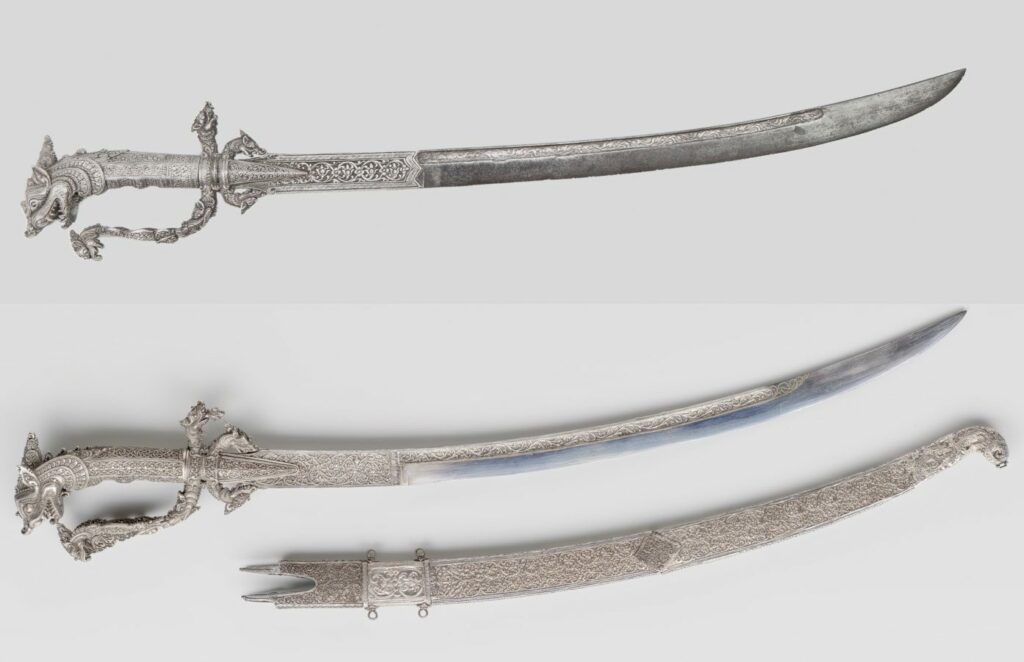
From 1467 to 1818, Kandy was an independent kingdom in Ceylon—present-day Sri Lanka. In the 18th century, the Kingdom of Kandy was recognized for its outstanding metalwork and craftsmanship. Unfortunately, their fine metalworking came to an end when Kandy fell under British rule in the early 19th century.
The kasthane served as symbols of rank and office, presented by the king to noblemen and local chieftains. The silver-mounted kasthane was reserved for the Adigar, the highest officials or feudal lords who also acted as ministers and governors. It also served as a diplomatic gift from the court to European visitors.
European Influence on Sri Lankan Swords
The Dutch East India Company (VOC or Vereenigde Oost-indische Compagnie in Dutch) regularly gifted swords to the Kandyan court as part of their strategy to protect their trading privileges. Many of these swords had the traditional Sinhalese decoration but with VOC-marked blades.
It was a Sri Lankan tradition to wear the kasthane as a symbol of rank to mark ceremonial occasions. However, the sword type, with an animal-decorated hilt and curved blade, was of European origin. It has its roots in the European hunting swords that were widespread among officers from the 17th to the 18th centuries.
Conclusion
Sinhalese swords are often not appreciated highly enough in the antique arms collecting community, but the kasthane is notable for its fine craftsmanship and ornamental hilt. The kastane sword served as an emblem of rank and a ceremonial item, remaining a significant part of Sri Lankan history.
